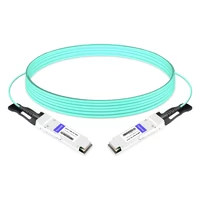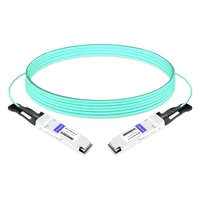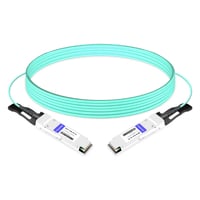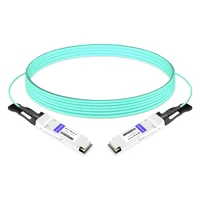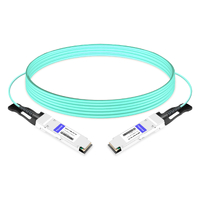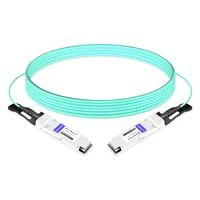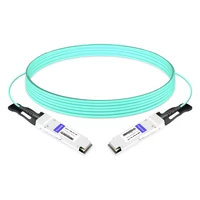In the modern world, understanding different transmission media is necessary to realize high-speed data transfer rates in networks. The 100G QSFP28 AOC (Active Optical Cable) has enabled such high data rates. This paper seeks to give an all-around description of 100G QSFP28 AOCs, including their technical specifications, main parts, and real-life advantages. After finishing this article, one should be knowledgeable enough about what advanced cable technologies like this can do to enhance the performance and efficiency of networks.
Table of Contents
ToggleWhat is a 100g QSFP28 Active Optical Cable?
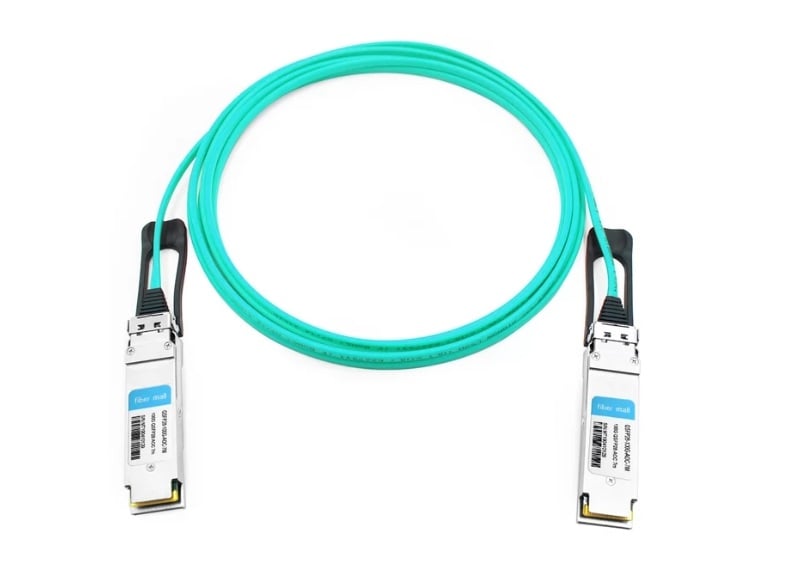
Defining 100g QSFP28 Active Optical Cable
A high-speed connection intended for data centers and HPC environments is the 100G QSFP28 Active Optical Cable (AOC). It merges four independent lanes of 25 Gbps each, thus giving a total data rate of 100 Gbps through fiber optics. Electrical and optical constituents are combined in the QSFP28 AOC to enable effective transmission of data with minimum signal loss as well as electromagnetic interference prevention. This kind of cable works best on interconnections that are within racks or between adjacent ones that are closer together; it has low power usage, high density, and can be easily deployed.
Key Features of 100g QSFP28 AOC
Fast Data Rate: A hundred Gb per second can be supported by a 100G QSFP28 AOC, having a high aggregate data rate.
Energy Saving: The AOC is intended to save power as usually it consumes less power than traditional copper solutions.
Noisy Signal Prevention and EMI: With electrical and optical parts in one device, the AOC guarantees minimum signal loss during data transmission and reduced electromagnetic interference (EMI).
Compactness: The small size of QSFP28 modules allows for more number of ports in data center racks thus enhancing space efficiency.
Easy Deployment: These cables are plug-and-play which means they do not need any settings to be made before use thus making installation easier and network setups less complex.
Suitability For Short Distances: The 100G QSFP28 AOC is best suited for intra-rack or inter-rack connectivity within data centers because it works well over short distances.
How the Active Optical Cable Works
Active optical cables (AOCs) work by converting electric signals into optic signals to enable high-speed data transmission. The following is a brief outline of how they work according to various sources:
- Electric-to-Optical Conversion: AOCs change electrical input signals from the data source to optical signals through transceivers embedded inside them. These transceivers are made up of a laser diode for transmitting data and a photodiode for receiving it.
- Optical Transmission: Once transformed into light pulses, these light signals pass through the optical fiber that runs through the cable. Optical fibers have wide bandwidths and can send information over long distances with little latency or loss in signal strength.
- Optical-to-Electric Conversion: Another group of embedded transceivers changes back received optical signals into electric ones so that they can be understood by the receiving device in an electronic form.
- Data Reliability: By using optic media, susceptibility towards electromagnetic interference (EMI) as well as signal loss is greatly reduced thus ensuring accuracy and efficiency during transmission of data.
To put it briefly, AOCs make use of optics for faster and more reliable data transfer which is very important in modern high-performance computing and data center environments.
Why Choose QSFP28 AOC over Other Cable Types?
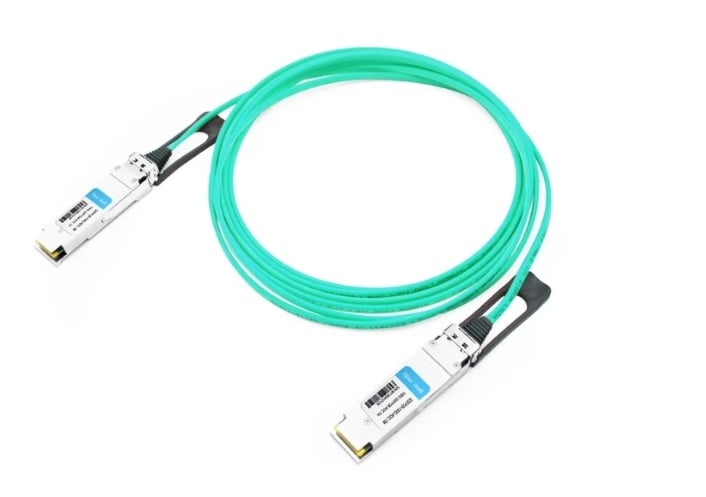
Advantages of 100g QSFP28 AOC Cables
- High Bandwidth: This supports data transmission at speeds of up to 100Gbps, making it suitable for high-performance computing and data centers.
- Low Latency: This maintains the shortest time delay when sending signals and thus enhances instantaneous processing of data.
- Extended Reach: Able to efficiently send data over further distances than conventional copper cables.
- EMI resistance: The latter guarantees a stable and secured method of transmitting information by rejecting electromagnetic interference better than other types of systems.
- Energy Efficiency: In comparison to other fast links, this consumes less electricity thereby resulting in reduced operational costs.
- Lightweight and Flexible: This makes them easier to handle and install while reducing physical stress on network infrastructure.
Comparing Active Optical Cable with Copper Cables
Active optical cables (AOCs) and copper cables have different features for various network requirements.
- Bandwidth and Data Rate: Data centers, high-performance computing, and other data-intensive environments can benefit from AOCs’ capacity to support higher bandwidths and data rates more than copper wires.
- Latency: Optical fibers enable faster signal transmission speeds in AOCs thereby reducing latency which is essential for real-time processing of data as well as applications with low tolerance times for responses.
- Transmission Distance: While copper cables are only capable of transmitting effectively up to 100 meters, sometimes even several kilometers without performance compromise can be achieved using AOCs.
- Electromagnetic Interference (EMI): EMI immunity, being an innate quality of active optical cables, makes them suitable for use in environments where there is high electromagnetic activity, while copper wires may experience this kind of interference that leads to degradation or loss of signals.
- Energy Consumption: When compared against each other, it becomes clear that AOCs use less power than their counterparts—copper cables—thus lowering operational expenditure across the entire network infrastructure and enhancing its energy efficiency.
- Physical Characteristics: In addition to being lighter weight-wise, active optic fiber cords also boast greater flexibility when contrasted alongside traditional metal wiring systems such as those made from copper materials. This simplifies installations while reducing physical stress on networking hardware components like switches, among others.
In conclusion, although still affordable over short distances, copper wires cannot match up with AOCS regarding factors like bandwidth, latency period, distance covered without performance drop-offs, resistance to electromagnetic interference (EMIs), power consumption levels, and ease of set-up, hence making them superior options used in long-haul communication networks characterized by high-speed requirements.
High Performance of 100g QSFP28
The QSFP28 is designed to meet the needs of different networks that require higher data rates. This transceiver can support 100 Gbps data rates, and it is made for high-density and multi-bandwidth networks. Some of its key performance metrics include:
- Efficient Bandwidth: The QSFP28 can transmit at 100 Gbps over a single duplex fiber which makes it very efficient in dealing with applications that have high bandwidth requirements but minimum hardware.
- Minimum Delay: The 100g QSFP28 uses PAM4 (Pulse Amplitude Modulation) among other advanced signal modulation technologies to reduce latency or delay, an important factor in real-time applications as well as data centres where information needs to be processed fast.
- Longer Distance: It supports various transmission distances, from a few meters using DACs (Direct Attach Copper cables) to 10 km over single-mode fiber (SMF), thereby providing flexibility for short-haul and long-haul networking requirements.
- Power Saving: Power saving mechanisms are employed while designing this module such that typically less than 3.5 watts are consumed by a QSFP28, which is much lower than its predecessors hence cutting down on operational expenses within data centers.
- Heat Control: More developed heat control capabilities enable the product to work optimally within specified temperature ranges even when deployed densely, thus ensuring continuity of services at all times.
In summary, the 100g QSFP28 module offers the strong performance required by today’s demanding networks, including high bandwidth, low latency, extended reach, power efficiency, and reliable thermal management features.
What Are the Applications of 100g QSFP28 in Modern Data Centers?
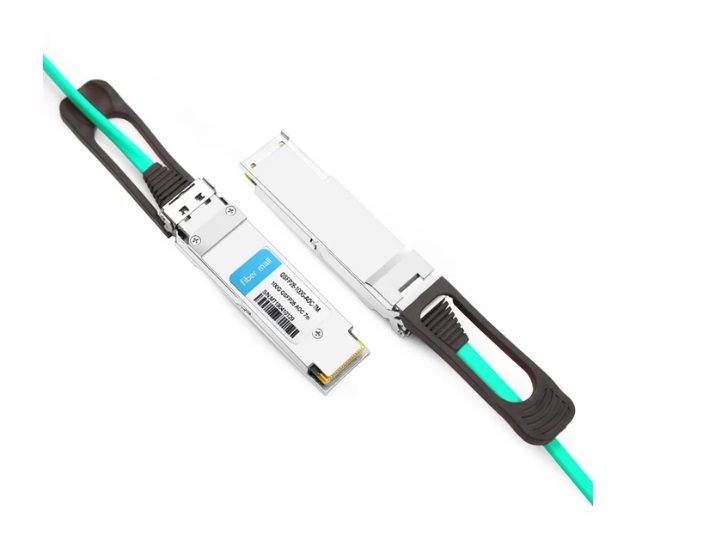
Use Cases in Data Centers
- High-Speed Data Transfer: The 100g QSFP28 module is ideal for facilitating high-speed data transfer between servers, storage systems, and network devices, thus providing smooth transference of information.
- Cloud Computing: The module boosts the cloud infrastructure with improved bandwidth and less latency to cater to the needs of demanding applications and services hosted in the cloud.
- Network Upgrades: The QSFP28 facilitates increased data speeds in a smaller space while upgrading existing network infrastructure as such it offers competitive scalability within limited physical capacities.
- Edge Computing: For massive data volumes management purposes in edge computing environments, the QSFP28 ensures real-time processing and low-latency communication.
- High-Density Environments: Designed to address high-density environment demands, this results in higher port density at optimized power and thermal efficiency rates.
Enhancing Ethernet Transmission
There are some important points to consider when enhancing Ethernet transmission with a 100g QSFP28 module. The first is that this device has a very high bandwidth and low latency, which can greatly improve performance in Ethernet networks by making data transfer faster and more efficient. Another thing is that it uses advanced modulation techniques like PAM4 (Pulse Amplitude Modulation), which allow for greater amounts of information to be sent over the same fiber link, thus maximizing available infrastructure. Also, power efficiency and thermal management features within the module help to ensure that it performs consistently under dense conditions while cutting down operation costs and enhancing reliability throughout the network. All these improvements together meet new requirements set by data centers today, such as higher data rates, reduced delays, and scalable strong network performance.
Application in High Performance Computing
The 100G QSFP28 module is very important in high-performance computing (HPC) environments because it can handle large amounts of data, such as those found in scientific simulations or complex calculations. This device has high-speed transmission capabilities and low latency, which are necessary for real-time analytics and other tasks that involve moving information quickly across many nodes within a cluster. In addition to this, parallel processing is often used in HPCs; therefore, robust thermal controls along with advanced modulation techniques employed by the modules ensure that they always work reliably under any circumstances so as to achieve faster speeds of computation as well as more efficient data processing while enhancing overall system performance.
What Are the Compatibility and Standards for 100g QSFP28 Active Optical Cable?
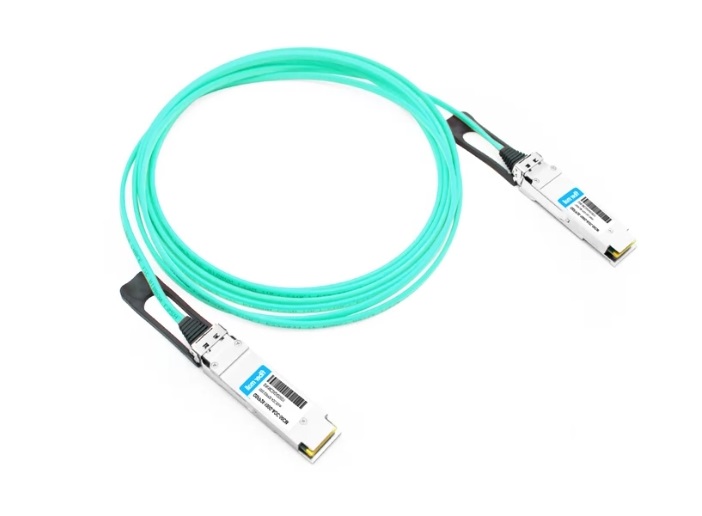
Compatibility with 100g QSFP28 Devices
The 100G QSFP28 AOC Active Optical Cable can be used with many other devices that also have the same 100G QSFP28 port such as switches, routers and NICs across enterprise networks or even in data centers. Based on the Multi-Source Agreement (MSA) for QSFP28 the cable will support any system which follows this standard thus making it possible to work even across different vendors.
Device Compatibility Overview:
- Switches: Cisco, Juniper, and Arista are just some examples among many other leading manufacturers who provide support for interfaces like those found on 100G QSFP28 modules; these enable high-speed connections both between data centers or within larger enterprise networks.
- Routers: For efficient backbone traffic management systems can be built using various types of hardware components including high capacity routers supplied by Alcatel-Lucent or Huawei which are compatible with 100G QSFP28 standard.
- Network Interface Cards (NICs): In order to establish fast links between servers in a typical DC environment it is common practice now to incorporate multiport adapters designed specifically for this purpose into host systems; they may come from such well-known vendors as Intel, Mellanox or Broadcom – all supporting 100GbE over copper/optical cables via their respective QSA+ transceiver modules.
Technical Specifications:
- Data Rate: Up to one hundred gigabits per second.
- Wavelength: Most often identified as eight fifty nanometers when talking about multimode fiber optics.
- Reach: Up to a hundred meters theoretically, but practically speaking, it should not exceed eighty meters due to power budget limitations imposed by OM4 grade fibers.
- Connector Type: Quad Small Form-factor Pluggable Twenty-Eight.
Standards Compliance:
- IEEE 802.3bm – Physical Layer Specifications for Ethernet Fiber Optic Connections at Speeds Greater Than Ten Gigabits Per Second Using Multimode Fiber Backbones.
- SFF-8665 – Electrical Interfaces, Mechanical Dimensions, and Management Interfaces for QSFP28 Transceiver Modules.
- RoHS – Restriction of Hazardous Substances Directive (Compliance) 2002/95/EC.
These technical specifications show that the total capacity of the 100G QSFP28 AOC should not exceed one hundred gigabits per second which can be achieved by using multi-mode fiber optics with the highest operating wavelength around eight fifty nanometers. However, due to power budget constraints imposed by this particular grade of fibers, its maximum reach may vary between eighty or even less than twenty meters only in certain cases when working over an OM4 cable assembly. Finally, the connector type is known as Quad Small Form-factor Pluggable Twenty-Eight.
Understanding QSFP28 MSA and Standards
The QSFP28 Multi-Source Agreement (MSA) refers to a joint effort by several manufacturers to establish universally accepted transceiver modules. These regulations are necessary for ensuring that different vendors’ equipment is compatible and reliable. The following are the main features of the QSFP28 MSA:
- Form Factor: This specification defines the mechanical dimensions of QSFP28 transceivers so that they can fit into racks or slots designed for this size.
- Electrical Interfaces: Electrical signal requirements are specified in order to ensure effective communication between QSFP28 modules and other networking devices.
- Thermal Considerations: Guidelines for heat dissipation and thermal management are provided by the MSA, which allows them to operate reliably in various environmental conditions over extended periods.
Compliance with such established standards enables seamless integration within the industry thereby widening network design options while at the same time guaranteeing uniform performance across high-speed data communication networks.
Interoperability with Other Transceivers
For networks to be flexible and scalable, it is important that QSFP28 interoperates with other transceivers, including SFP+, QSFP+, and CFP modules. Various transmission protocols and data rates are supported by QSFP28 modules, which can work well with other transceivers that have been standardized. This is achieved through adherence to Multi-Source Agreement (MSA) standards, which define common mechanical, electrical, and thermal specifications for use across different types of transceivers. In order to verify trouble-free support for upgrades or expansions within existing network infrastructures, vendors test their QSFP28 modules widely in multi-vendor environments. Hence, any designer can confidently deploy any of the available QSF28 solutions, being sure they will seamlessly blend in with a wider range of transceiver technologies.
How do you select the right AOC cable for your needs?
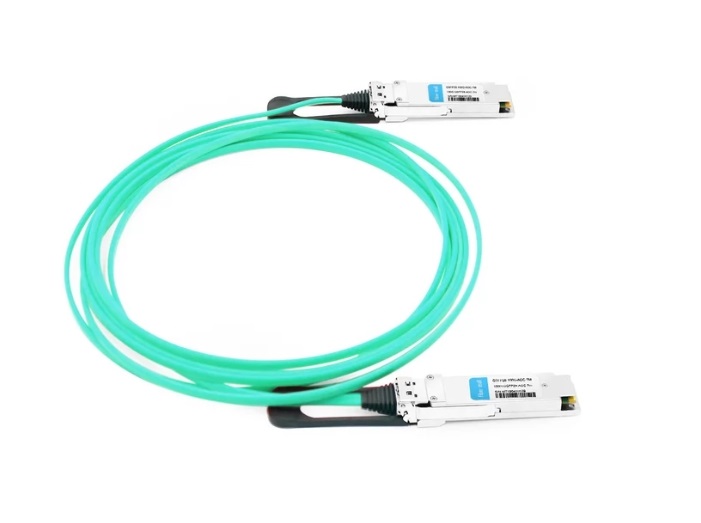
Factors to Consider for Cable Assemblies
- Data Rate Requirements: What amount of data will your network need to transfer within a specific period?
- Cable Length: How far apart should the connections be in order for the cables to maintain signal integrity over the desired range?
- Environmental Conditions: In what type of environment, including temperature and humidity levels, would cables with suitable thermal and mechanical properties work most effectively?
- Connector Type: Which types of connectors are needed to match transceivers and other equipment?
- Budget Constraints: Can we balance system performance requirements against its cost so as to get the best solution within budget?
- Vendor Compatibility: Is it certain that such cables can work well with different vendors’ gear so that your system remains open-ended and scalable?
Choosing the Correct Cable Length
To select the appropriate cable length, you need to know how far apart the devices are. You should look for a cable that is long enough to cover the distance between two points without either stretching it too much or leaving too great a margin which can result in degradation of signals or material damage as well. Also, take into account any future re-configurations or expansions that might require more adaptable routing paths. Thus, determining the right cable length depends on an equilibrium between signal integrity, cost implications, and potential future network changes.
Assessing Data Rate Requirements
It is important to determine the data rate requirements so as to optimize the network performance and avoid bandwidth restrictions. First of all, one needs to assess the maximum data rate required by looking at what applications or services are being used in a given network. This may involve streaming high-definition videos and transferring large files, among others, which usually demand higher data rates. Secondly, evaluate the infrastructure of your system with regard to its ability to handle expected levels of traffic; take into account available equipment and their capacities vis-à-vis anticipated speeds. Finally, future increases in information flow should be considered, thus selecting cables and devices that can carry larger loads without requiring extensive upgrading. Proper planning at this point will ensure that current demands are met while leaving room for expansion using appropriate hardware, such as wires and gadgets.
Reference Sources
Frequently Asked Questions (FAQs)
Q: What is a 100G QSFP28 Active Optical Cable?
A: The 100G QSFP28 Active Optical Cable (AOC) is a high-speed data communication and interconnect application-oriented cable assembly that delivers robust performance. To link between the data center’s 100G Ethernet ports, lower latency fiber optics for data transmission are usually used, hence achieving higher bandwidth.
Q: What comprises a 100G QSFP28 AOC?
A: Some parts of the 100G QSFP28 AOC include electronic circuitry necessary for converting electrical signals into optical signals or vice versa, transceivers, high-quality fiber cables, and QSFP28 connectors, among others. These components function together for reliable and effective data transfer.
Q: Why should I use a 100G QSFP28 AOC instead of other cables?
A: Compared to traditional copper cables, there are many advantages of using 100G QSFP28 AOCs, which include having more bandwidth capacity, longer distances covered during transmission, low power consumption, and minimal electromagnetic inference. For this reason, such active optical cables would be perfect in any high-speed data center where both performance and reliability count most.
Q: Are different types of network equipment compatible with them?
A: Yes, indeed, they are made to work with different kinds of network equipment, so they may also be referred to as compatible 100G QSFP+ DACs. These can be employed on switches, routers, or any other networking devices that support interfaces such as those based on Ethernet standardization up to one hundred gigabits per second.
Q: What distinguishes between 100G QSFP28 AOCs from DACs?
A:The main difference is in the medium used to transmit signals—while AOCs utilize optical fibers, thereby providing a wider frequency response range at longer distances, DAC uses copper, which generally offers the lowest cost but less optimal performance over short-distance links.
Q: Can 100G QSFP28 AOCs be used in breakout configurations?
A: A 100G QSFP28 breakout AOC is an example of a breakout configuration that can use 100G QSFP28 AOCs. This allows dividing a single 100G port into several ports with lower speeds and can help flexibly design networks while using available bandwidth more efficiently.
Q: What is the maximum transmission distance for 100G QSFP28 AOCs?
A: The maximum transmission distance supported by 100G QSFP28 AOCs depends on various factors such as cable assembly and fiber quality. However, they can generally support distances up to or greater than 100 meters, making them suitable for most data center applications.
Q: How do 100G QSFP28 parallel active optical cables differ from other types of AOCs?
A: 100G QSFP28 parallel active optical cables are unique because they allow multiple data streams to be transmitted at the same time through different parallel fiber optics, hence giving larger cumulative bandwidth than serial AOCs, which results in better performance. This makes them perfect for applications where very high data rates are required.
Q: What are custom cable assemblies, and are they available for 100G QSFP28 AOCs?
A: Custom cable assemblies refer to cables made specifically according to given requirements or specifications; these are also known as bespoke cables. They are available for use with 100G QSFP28 AOCs, allowing users to select desired lengths and connector types, among other features, to meet their unique network needs.
Related Products:
-
 QSFP28-100G-AOC-50CM 50cm (1.6ft) 100G QSFP28 to QSFP28 Active Optical Cable
$84.00
QSFP28-100G-AOC-50CM 50cm (1.6ft) 100G QSFP28 to QSFP28 Active Optical Cable
$84.00
-
 QSFP28-100G-AOC-1M 1m (3ft) 100G QSFP28 to QSFP28 Active Optical Cable
$85.00
QSFP28-100G-AOC-1M 1m (3ft) 100G QSFP28 to QSFP28 Active Optical Cable
$85.00
-
 QSFP28-100G-AOC-2M 2m (7ft) 100G QSFP28 to QSFP28 Active Optical Cable
$86.00
QSFP28-100G-AOC-2M 2m (7ft) 100G QSFP28 to QSFP28 Active Optical Cable
$86.00
-
 QSFP28-100G-AOC-3M 3m (10ft) 100G QSFP28 to QSFP28 Active Optical Cable
$88.00
QSFP28-100G-AOC-3M 3m (10ft) 100G QSFP28 to QSFP28 Active Optical Cable
$88.00
-
 QSFP28-100G-AOC-5M 5m (16ft) 100G QSFP28 to QSFP28 Active Optical Cable
$90.00
QSFP28-100G-AOC-5M 5m (16ft) 100G QSFP28 to QSFP28 Active Optical Cable
$90.00
-
 QSFP28-100G-AOC-7M 7m (23ft) 100G QSFP28 to QSFP28 Active Optical Cable
$95.00
QSFP28-100G-AOC-7M 7m (23ft) 100G QSFP28 to QSFP28 Active Optical Cable
$95.00
-
 QSFP28-100G-AOC-10M 10m (33ft) 100G QSFP28 to QSFP28 Active Optical Cable
$98.00
QSFP28-100G-AOC-10M 10m (33ft) 100G QSFP28 to QSFP28 Active Optical Cable
$98.00
-
 QSFP28-100G-AOC-15M 15m (49ft) 100G QSFP28 to QSFP28 Active Optical Cable
$103.00
QSFP28-100G-AOC-15M 15m (49ft) 100G QSFP28 to QSFP28 Active Optical Cable
$103.00

